How to be a Top Player on Weibo
- Caifu Magazine | by Star
- EN
Weibo‘s ties with Canada started in late 2017, when Canadian Prime Minister Justin Trudeau chose Sina Weibo’s headquarters in Beijing as his first stop on his first official visit to China. In line with the G-20 summit during that time, Weibo held an online theme campaign with the hashtag Tour Canada Together. With the topic reaching 360 million hits within 24 hours, Weibo kicked off a good start for the China-Canada tourism year. In 2018, more information about Canada, Canada travel, and China-Canada exchange appeared on the Weibo platform.
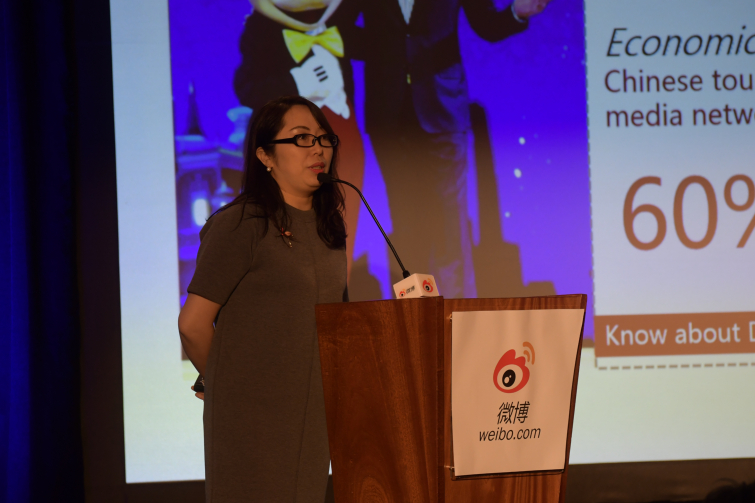
Lisa Wang, Weibo’s International Deputy General Manager
Today, there have been many successful cases of brand marketing in Weibo history. When The Walt Disney Co. opened Shanghai Disneyland in China, a Chinese real estate tycoon predicted that Shanghai Disneyland might not make money for 20 years. The fact is Shanghai Disneyland became profitable merely one year after its opening. A high-level executive of Shanghai Disneyland once said that almost 60 percent of its customers came from social media. Most people got to know Shanghai Disney from social media and Weibo. Compared with the traditional way of marketing for Disney, the influence on Weibo is far-reaching.
To get better promotion and marketing, Shanghai Disney began early to lay out an entire plan on social media. The success is mainly a joint result of its use of two social media platforms, WeChat and Weibo.
On the Weibo platform, Shanghai Disney focused on some key activities, such as star influences, fans marketing, short videos, live broadcasting and web celebrities. These activities produced a lot of high-quality content, as well as the spread of influence. In addition, Shanghai Disneyland put much effort on encouraging visitors of the newly opened Disney to share their wonderful experience on social media, which has produced a very good brand reputation. On the WeChat platform, on the other hand, Shanghai Disney instead employed more of a peer-to-peer strategy. The difference between Weibo and WeChat usage in the eyes of the Weibo team will be discussed later in the article.
Canada on Weibo
The internationalization of Weibo is reflected in many aspects, one of which is reflected in the variety of the Weibo account. There are many types of user accounts related to Canada on Weibo, such as Orange V, Gold V, and Blue V. All have different account attributes and identities to some extent. For example, Gold V enjoys a higher level of privilege than Orange V, and can exercise much more influences, with bigger fan base and more fans interaction. Canada-related companies and institutions, such as the Prime Minister of Canada and Destination Canada are also very active on the Weibo platform with their own respective accounts.
There are also a large number of Weibo accounts for Canada-related individuals and organizations. According to the data analysis of Canadian users by the Weibo team, there are 609,316 registered users in Canada, among which monthly active users (MAU) and daily active users (DAU) are 67,724 and 47,197, respectively. The two numbers for Canadian users are not high compared with user data in other countries. There are many Chinese users in both Canada and Australia, but the overall level of activity is not high in Canada. Thus, there is still a lot of room for growth.
Canadian users, as shown in the data analysis, have the following characteristics: a higher education level in general, more younger users, relatively more common users, and more users in first- and second-tier cities, which indicate the overall level and quality of users is rather good for those coming to Canada. Although the overall MAU and DAU values of a Canadian user are not high, when Canadian topics and keywords are in discussion or debate, these two values are relatively high. This scenario reflects several points: one may be that the entire Chinese user community – including Chinese users inside China – on the Weibo platform are very interested in Canada, thus generate more discussions; the other one may be migrating Chinese users (referring to Chinese users who travel frequently between China and Canada) contribute a lot of content related to Canada. They may be contributors of many content, and they may also become collaboration partners, as well as targeted audiences for marketing. The data shows that Canadian-related keywords include Canada, Vancouver, Canadian real estate, Canadian skiing, which are most searched online, are those indicator words that show what users are interested in about Canada. A high volume of mentions indicate that quite a few users are concerned about Canada. There must be good content that can be discovered and disseminated, therefore creating opportunities for relevant brands and companies to make good use of this information.
About Today's Weibo
In addition to the numbers, there are many ecosystems and structures of different perspectives on Weibo. For example, there is a rather high number of self-media from key-opinion leaders (KOLs), or influencers, and web-celebrities, among which KOLs of tourism exceeded 100,000 in number. According to the latest financial report, Weibo's MAUs are nearly 446 million, and DAUs are close to 195 million. These users cover about 190 countries and regions, and 93 percent of them logon through mobile terminal devices, thanks to China’s curved overtaking development resulting in its world-leading mobile network technology. As for the overall number of posts, short videos and live broadcasts show higher numbers, which is consistent with the overall development trend of Weibo. Weibo will promote whatever the consumers and users are interested in with corresponding forms that they like most, according to the current market trends. Currently, short videos and live broadcasts are the forms that are easily accepted and disseminated by consumers.
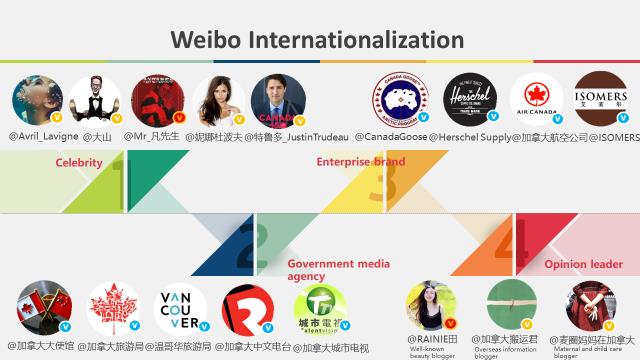
From the analysis of the overall Weibo user data, 82 percent of users are under 30 or around 30 years old. While obviously young users consist of its majority, other age groups are not absent. Its parent company, Sina.com of Sina Group, is China's first-generation internet portal. As one of the internet leaders, Sina has accumulated a lot of quality user groups – currently all middle-aged and above – with high-income and high-education backgrounds active on its content channels in finance, sports, technology, and news. Because the two listed companies share the same user data at the bottom level, Weibo can still take advantage of data to reach older users, therefore Weibo’s overall user coverage is pretty wide. The geographical distribution of Weibo’s users illustrated that it has deeply penetrated to the second-, third- and fourth-tier cities after user numbers in the first-tier cities have reached a plateau, and it has done a good job in vertical sink, with steady user growth regionally. In the current Chinese market, we cannot underestimate both the users’ activity level and their contribution commercial-wise due to their purchasing power in second- and third-tier cities. Because as users in those regions, they are eager to overcome the restriction of reality and find out online about first-tier cities users’ preferences, their habits of consumption, and information acquisition channels.
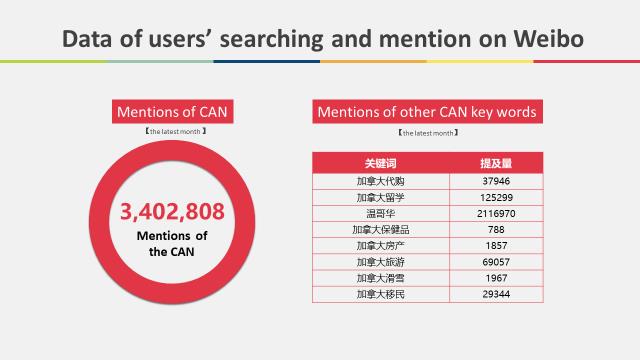
The user data of tourism alone indicates that on Weibo, there are a large number of people interested in tourism, tourism-related topics and tourism-related accounts. Many users have gradually developed a good habit to actively search on the Weibo platform. For example, before travelling, they will be more inclined to search for tourist strategies and recommendations on Weibo instead of using the Baidu search engine. Therefore, it is recognized that Weibo is China's largest real word-of-mouth platform. Compared with keyword-searching on Baidu that mostly yield advertisements, users searching for keywords on Weibo can directly see the real accounts registered by the people who provide information, and they can enter their homepages through these accounts to see the trajectory of more content produced by them, through which users can easily judge the level of authenticity of word-of-mouth.

Currently Weibo has 300 million search activities daily. Some users will go to other platforms after searching for keywords on Weibo to make comparisons. They are smart users because they have developed good habits of raking through an ocean of information to find useful information. Weibo currently has 25 million overseas users registered, while overall overseas users reach 36 million. The analysis indicates that many overseas Weibo users often travel to other countries, and the number of people who travel to China for the first time is also decreasing annually. Many Chinese choose to travel to different places in one year.
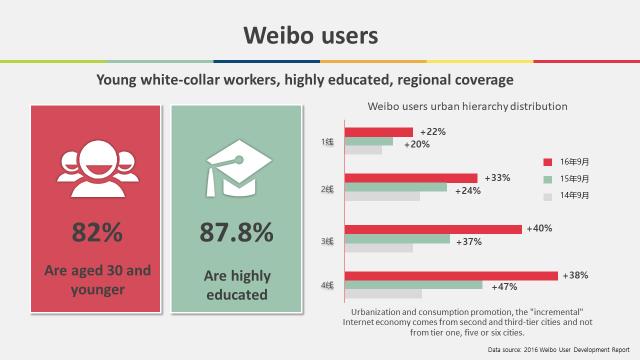
The Difference between Weibo and WeChat
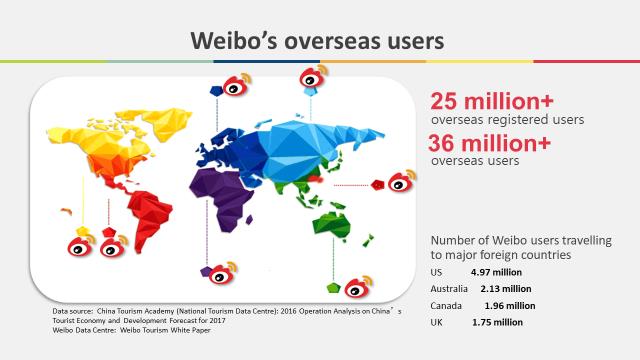
In essence, the two products, Weibo and WeChat, are product platforms with completely different product genes. While WeChat replaces SMS—a peer-to-peer, strong-relational social tool product—Weibo is a social media platform with stronger media behavior and weaker relationally. Weibo is like a public square, while WeChat is more like a private building. For most people, whether it is to promote their own products, brands, accounts or related information and content, Weibo is the first choice. Because promotional information on Weibo can allow more people to see and then trigger fission and viral diffusion, which are brought about by Weibo’s nature of serving as the media. From a comprehensive comparison in terms of openness, privacy, relationships and interests, Weibo tends to be a more open, interest-oriented platform, whereas WeChat is a more intimate, relationship-oriented platform. For those who want to do marketing, both can be used jointly. They can use Weibo to do branding and improve their brand awareness first, and then use WeChat to do more peer-to-peer services.
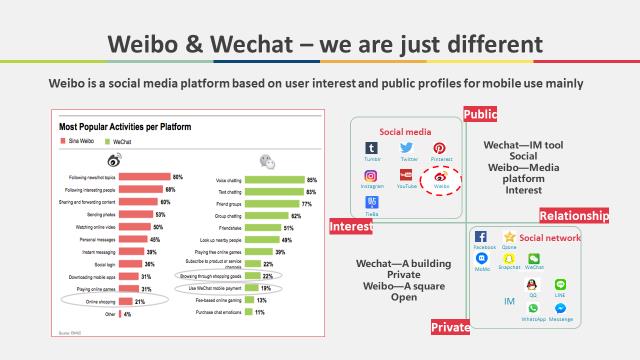
Since its inception in 2009, Weibo has been in a hot state at the beginning. With the birth of WeChat, since users' time has been diverted, Weibo has suffered a quiet period during which Weibo completed sinks in two aspects: one sinking geographically, the other the vertical sink, namely, sinking to different vertical fields according to interest classification. In the regard of forms of content in presentation, along with the growth and development of Weibo, it has kept on expanding the diversity of expression forms, from the beginning of text-only, to later-on with pictures, videos, long Weibo and Weibo 15-seconds story, including current products, such as free and paid Weibo Q&A. To some extent, Weibo in China is the equivalent of combining Twitter + Facebook + YouTube + Instagram. All the features of these other platforms are all available on Weibo.
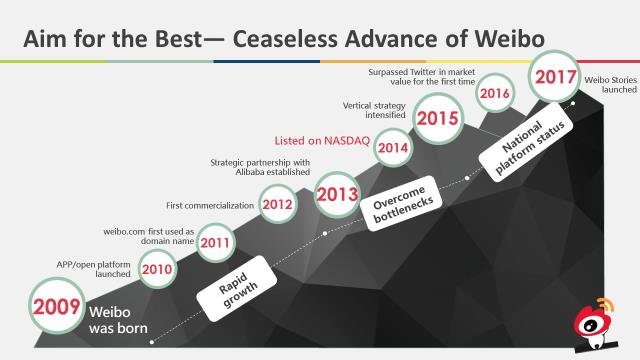
In the above introduction we mentioned that there are different vertical areas divided by interest. Weibo currently has at least 45 vertical areas, of which nearly 25, such as food, fashion and beauty, mother and child, and tourism, have monthly exposures of 10 million and more. Another strategic shift of user sink that Weibo has accomplished is to foster these different areas, aiming at not only the content, but at the more important aspect – the content producers – to support people and accounts. The early stage of Weibo has mostly stars and Big Vs (KOLs) as users. After 2014, Weibo started supporting people in different fields, thus making them Medium- and Small Vs, because Weibo hopes that they will contribute more to this layer/circle with quality content. This is why many doctors, lawyers, travel experts, mother and baby experts, and gourmets became active on Weibo, resulting in a boom of colorful scenes with multiple forms. In other words, if certain user is a professional in a certain field, or has his/her own insights and can produce high-quality content, there is good chance for them to become a KOL in this field. Weibo operators encourage and strive to build this kind of ecology of KOL.
There are many types of web celebrities on Weibo, such as Vlogger celebs (the familiar Papi Sauce), fashion web-celebs, live-celebs, and e-commerce celebs. Since Alibaba Group injected investment in Sina Group, Weibo also opened up the end-user data to share with Alipay, which explains why e-commerce web-celebs are shining stars on Weibo. Web-celeb ecology is also a very important part of Weibo. According to past data, during Singles Day, or the annual 11.11 event, among the top 10 sales stores of women’s fashion, eight of them are web-celeb stores, and more than half of the total traffic contribution during the entire event comes from the diversion of Weibo. Based on such ecology and developmental needs, Weibo has made a lot of improvements and changes at both the product end and the functionality end -- among them, setting up display windows for e-commerce web-celeb homepages and product details pages, to allow the users adding products to their shopping carts with one click; or allow them to buy while watching and check multiple products with one click, in the case of an e-com celeb’s live broadcast.
The logic behind Weibo’s account operation is quality content first, no matter the aim – either the content itself or its business. We attract fans through content, and then develop potential customers through continuous high-quality interaction with fans to establish emotional connections. Then, potential customers will eventually be transformed into actual customers, thus close the loop of users— brands— businesses triangular relationship. Weibo is more than just a platform for traffic. It is an empowering agency for businesses, brands, and users. The healthy development of this kind of ecology is actually constructed and promoted from different dimensions.
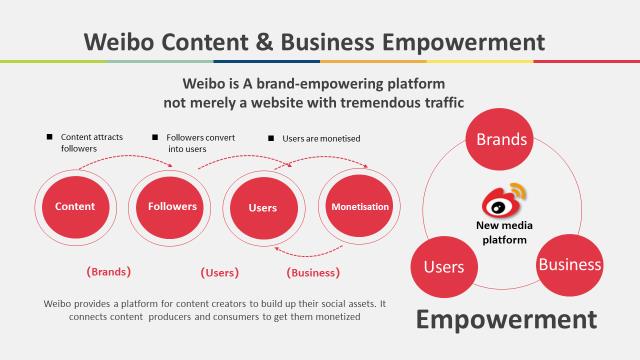
Weibo's commercial advertising forms share many similarities with Facebook in North America. There are four categories, if we categorize it roughly by way of presentation channels: highly-recognizable advertisements with strongest exposure; advertisements that are imbedded in the information flow of content to reach accurately targeted users; ads that reach the interested users through search activities; and topic-specific ads. All are under constant updating and upgrading every year.















